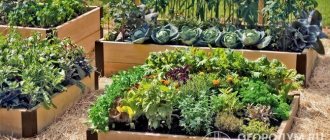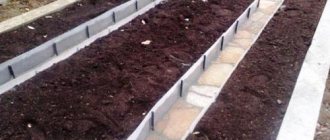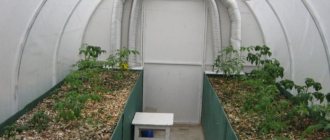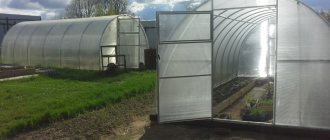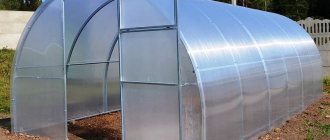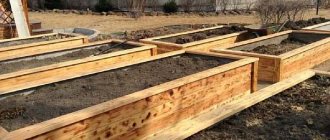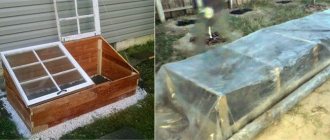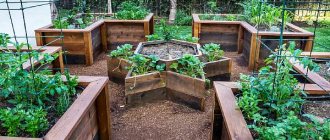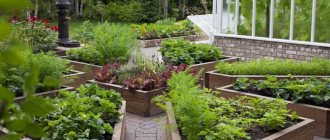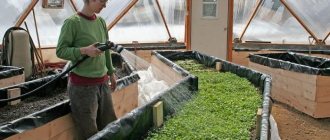- How to increase your cucumber harvest
- 2 ways to grow early cucumbers
- How to use food waste
- Optimal feeding of cucumbers
- Cucumbers are losing their appearance
- Feeding cucumbers with ash
- Self-watering cucumbers from a warm barrel
- Cucumber seedlings do not sprout
- Bad place to plant cucumbers
- Conditions for growing cucumbers
All Collapse
Cucumber beds begin to be made when the surface layer of soil warms up to at least +15°C. You can choose different designs as a basis - for example, a classic or warm bed. In areas with a small area, cucumbers are grown vertically, in barrels and even in durable bags. We have collected ideas on how to make different beds with your own hands.
Features of cucumber beds
Cucumber grows well in soil rich in organic matter. When setting up a bed of any type, compost is added to the soil, mowed grass, thin branches, and food waste are added. During overheating, organic matter releases a lot of heat. In addition to improving the nutritional value of the soil, increased temperature sterilizes it. Most of the pathogenic microbes and pests die. Cucumber grows well in soil fertilized with organic matter.
As for the arrangement of the beds themselves, they are made warm or ordinary. Pyramids, suspended and mobile structures are erected. They make structures that are tall, deep, and vertical.
Important! The manure and warm beds have approximately the same structure and functionality. The difference is the organic filler.
Useful tips from experienced gardeners
- For a cucumber bed, it is advisable to choose a place where the wind will not blow.
- There should be no running water at the planting site.
- It is advisable to choose a warm area for planting.
- It is worth paying attention to what grew to cucumbers in that place. Is it possible to plant cucumbers after those crops?
- You can water cucumber seedlings with warm water, because cold water will destroy the plant. It should be remembered that cucumbers are a heat-loving crop.
- It is better to plant planting material in the soil at the end of April. This will allow you to achieve maximum yield. Cucumbers are planted in greenhouses even until late autumn.
- Regularly clear cucumber beds of weeds. During the growth of the vegetable crop, weeds should be controlled. You can treat the place where cucumbers grow with chemicals.
Building beds and caring for cucumber bushes does not take much time. And with the right approach, the beds will delight the owners with a bountiful harvest.
0 0 votes
Article rating
Types and shapes of beds for cucumbers
Rectangular places for planting vegetables are considered classic. However, their shape does not affect the growth of cucumbers. If desired, the owner can make the bed square, round, triangular, and even give it the appearance of an animal or any object.
Vertical beds for cucumbers
If the plot is limited to a small area, cucumbers are grown tied to a trellis. Vertically growing vines are easier to care for and easier to harvest. Vertical cucumber beds are arranged not only with the help of trellises. Garden crops are planted in cut bottles, flower pots, attached to a support, which can be a building wall, a fence, a pole, or an old tree.
The most popular is a vertical support made from a hut-shaped trellis. The structure expands downwards with a cone, forming a round seat. It is filled with organic waste and cucumbers are planted. The stems are allowed to weave along stretched ropes converging at one point from above.
A vertical bed has a number of advantages:
- the decorative nature of the structure allows it to be used to decorate the site;
- the device allows you to grow a lot of cucumbers, occupying a minimum of space;
- convenient care of plants, small cultivated area;
- the absence of contact of green mass with the ground allows you to avoid common cucumber diseases.
However, when grown vertically, cucumbers require increased feeding with phosphorus. The vines are blown more abundantly by the wind and illuminated by the sun, due to which the moisture evaporates faster. The crop needs to be watered more often.
Important! When growing cucumbers vertically, the plant's need for phosphorus increases to 30%.
Raised beds for cucumbers
The high bed is a box-shaped structure. The sides hold the nutrient substrate where cucumbers grow. The structure is a type of warm bed. The filler is organic matter, mineral fertilizers, and black soil. High sides prevent weeds from clogging the cucumbers from the side.
Warm beds for cucumbers
Warm beds are based on the use of organic matter as a planting substrate. Branches, grass, paper, food waste, manure, soil are laid in layers. During overheating, organic matter releases useful microelements and heat, which has a beneficial effect on the growth of cucumbers.
Warm beds differ in design:
- A buried type structure requires digging a trench. All organic components are loaded into the pit. The prepared filler is flush with the ground or slightly raised.
- A raised or tall structure is built on the surface of the earth. You can remove the top layer of turf with grass with a shovel or not. The fencing is the sides of the box, made of boards, iron, slate or plastic.
In terms of efficiency, a recessed type structure wins. Decaying organic matter retains heat better and there is less moisture loss. To build a sunken bed for cucumbers, dig a trench. Dimensions are optional, but the optimal parameters are considered to be a depth of 1 m and a width of 1.5 m.
The turf layer is used to fill the hole. Infertile soil is removed. The bottom of the trench is covered with large organic matter: pieces of wood, logs, cuttings of boards.
Grass, tops, and tree leaves are placed on top of large organic matter. It is advisable to lay a layer of straw between the green mass. Organic matter is moistened generously with warm water. For quick reheating, add Baikal EM. The organic substance is covered with film and left for 7 days to begin the process of overheating. After time, the shelter is removed, a 20 cm layer of fertile soil with compost is poured on top of the organic matter, covered for another week, and only after that the cucumbers are planted.
The advantage of the technology is the possibility of early production of greens. The disadvantage is high labor costs.
More details about the technology are shown in the video:
Pyramid beds for cucumbers
A pyramid is a type of vertical bed. Usually it consists of a set of boxes of different sizes. They are installed on top of each other using the pyramid method, filling with earth. When growing cucumbers, you must remember that vertically tied vines create a lot of shade. It is better to plant shade-tolerant plants, such as salad greens, on the back shaded side of the pyramid.
Round beds for cucumbers
A convenient pyramid cucumber bed is round in shape. You don’t even need to put together a box for it. The technology involves digging circles 40 cm deep in the area. The diameter is arbitrary, but not too large. The excavated soil is laid out between the circles. Manure 15 cm thick is poured into the hole, and black soil is placed on top. The surface of the filled circle should be 5 cm below ground level.
Cucumber seedlings or their seeds are planted in a circle. Growing stems are tied to ropes. The surface of the earth in circles is covered with mulch. Technology is good for the culture itself. Cucumbers love watering at the root. It is convenient to pour water into the circle with a bucket without splashing the green mass, and to spud up the exposed roots.
Beds in a barrel for cucumbers
Convenient and beautiful beds for cucumbers are made from old barrels. The structure requires little space on the site. Barrels can even be placed in the yard. It is optimal to use 200 liter containers for growing cucumbers. The outside of the barrels is painted. The bottom is perforated for drainage to prevent water stagnation.
The inside of the barrel is filled with organic matter. The method is similar to arranging a warm bed for cucumbers. Grass, branches, tops are loaded in layers. The organic matter is covered with straw and filled with a special leaven, which is infused for three days using bread, water and potato peelings. The barrel is covered with film. In a week, the organic matter will begin to rot and settle. Grass with compost and hay is again added to the barrel, the top is covered with soil and the film cover is returned again. After three days you can plant cucumbers.
Smart bed for cucumbers
Using modern technologies, a smart bed for cucumbers in the open ground in the spring is set up according to the method of N. Kurdyumov. The prepared substrate not only generates heat, but does not require loosening. The whole process is controlled by beneficial bacteria. The vegetable grower just has to plant the cucumbers, tie them up, and wait for the harvest.
Box-bed for cucumbers
Like a warm bed, a box is prepared for planting cucumbers. The length of the structure is taken arbitrary, optimally 3.5 m. A convenient width of a bed for cucumbers is considered to be 80 cm. Preparation begins in the fall, but first, in the third decade of August, ash is added and green manure is sown, for example, mustard. In September, three buckets of compost are added. Green manure is mowed and laid. In October, a ditch is dug in the middle of the embankment, loaded with leaves, watered with warm water with dissolved Fitosporin, and covered with compost. The contents of the box are covered with agrofibre.
Preparation of the bed for cucumbers begins in the spring two weeks before planting. The contents of the box are filled with warm water and covered with film. A couple of days before planting, a trench is dug again in the middle of the embankment. The depth is approximately the size of a shovel, and the width is about 60 cm. The bottom of the trench is covered with a layer of humus 7 cm thick and watered with a warm solution of the Baikal EM-1 preparation. The substrate is covered with film. Before planting cucumbers, the trench is watered again.
Mobile beds for cucumbers
To arrange a mobile structure, you will need any container. A barrel, a strong bag, a box, a pipe and other similar devices will do. The container can even be placed on wheels and moved with growing cucumbers. The loading is done with organic matter. The technology is similar to arranging a warm bed.
Advice! In order to get the maximum harvest of cucumbers from a mobile bed, some of the vines are allowed to trail along ropes, and several stems are left to hang freely and spread along the ground.
Pipe beds for cucumbers
Sewer pipes are often used for growing berries, herbs, and flowers. If you wish, you can try growing cucumbers. For a vertical structure you will need a PVC pipe with a diameter of 150 mm. The blanks are cut into lengths of 1 m. From a pipe with a diameter of 50 mm, blanks with a length of 1.1 m are cut, the walls are perforated with a drill, and wrapped with geotextile. The elements will be used for watering. They are inserted inside a thick pipe, the gap between the walls is filled with soil mixture.
The structure is installed vertically. Windows with a diameter of 100 mm are cut out in the walls of a thick pipe, where cucumber seedlings are planted. During irrigation, water is poured into a piece of thin perforated pipe protruding in the center.
Closed beds for cucumbers
You can organize closed beds in a greenhouse or greenhouse. The second method is the simplest. It is enough to install the arcs and cover them with film or agrofibre. It is more profitable to place a greenhouse on rotting organic matter, where you can get an early harvest of cucumbers.
You can also call a closed bed the soil on which is covered with black agrofibre. Cucumbers grow in cut-out windows. The advantage of the technology is the absence of weeds and less moisture evaporation.
Priming
It is more convenient to use a ready-made substrate purchased at a gardening and gardening store. Such mixtures already contain all the necessary nutritional components and are completely ready for use. It is much cheaper to prepare the soil mixture in a container yourself.
Tips for a summer resident: What should the soil be like for planting seedlings?
The principle of preparing land for planting is a bit like the technology of laying warm or high beds.
Related article:
Fertilizing cucumbers: useful tips
Step-by-step instruction:
- Pour drainage into the selected container.
- Add a layer of natural origin. For example, compost, fallen leaves, sawdust, greens, food scraps or shredded plant stems. When fresh manure is taken, it is recommended to place it at the very bottom of the bucket.
Along with the proposed technology for laying layers, there is another opinion among agronomists about preventing such actions. This is explained by the fact that during the season, food waste, branches of bushes and grass will not completely rot, and the risk of infection by pathogenic microorganisms will increase significantly.
- EM preparations can be used to assist the decomposition process.
- In a 1.5 liter plastic bottle, cut off the bottom, remove the cap and use a knife to make holes in the walls.
- Install in the center.
- Cover with substrate.
- If soil from the garden is used, then due to the high risk of infection with various diseases, disinfection is necessary. You should spill the contents first with hot water and then with a solution of potassium permanganate.
- Cover with film and leave for 7-10 days. During this period, the mixture will settle and become denser; if necessary, you can add more soil later.
Another universal recipe for mixing the substrate is the following option:
- Take sand, turf, ash, rotted pus and manure in equal parts.
- Combine in a large basin, add 10 g of complex fertilizer containing phosphorus, potassium and nitrogen to 10 liters of mixture.
- Mix well, pour into a container, pour hot water to compact everything.
Calcining the soil in the oven reduces the risk of disease and pest damage.
How to make a cucumber bed with your own hands
To get the right bed for cucumbers in open ground, you must initially choose one of the technologies for cultivating the vegetable. According to the method, fencing material is selected (if needed), and a soil mixture is prepared.
How to make a raised bed for cucumbers
For a high warm bed you will need a box. The length is arbitrary, and the width is a maximum of 1 m. The original box can be knocked down even on a wide stump of a cut tree, which will act as a stand. The site for arranging the planting site is chosen to be sunny, slightly blown by a cold wind. Organic matter is loaded inside the box in layers, starting with large wood waste. Manure 10 cm thick is poured on top of the green mass and straw. The final layer is fertile soil 10 cm thick. 2 cups of ash and half a cup of nitroammophoska are added as fertilizer per 1 m2.
If the structure for cucumbers is prepared in the spring, then its contents are poured with boiling water and covered with black film or agrofibre. In a week, the organic matter will begin to rot and the temperature will rise. The cover is removed, a 20 cm thick mixture of soil and humus is poured in. The organic matter is covered again until the cucumbers are planted.
When planting in the fall, they do not wait until the process of decomposition of organic matter begins. It is immediately covered with earth and humus on top and covered with film until spring.
How to make vertical beds for cucumbers
There are many options for creating vertical beds. To grow cucumbers this way, you will need containers and supports.
A popular device among summer residents are old tires. They are filled with soil mixture, windows are cut, and seedlings are planted. Tires can be folded in tiers. Plant strawberries or other greens on the bottom and cucumbers on top.
PVC pipes are the ideal material for arranging a beautiful and compact garden bed. They can be placed individually or using shaped elements to form a large structure in the form of a pyramid, wall or other geometric figure.
An excellent option is construction mesh. It can be installed as a trellis along the cucumbers growing in the garden bed or twisted into a ring with a diameter of 400 mm. In the second case, the structure is installed on the ground. A thin layer of straw and soil mixture are poured inside the ring, and cucumber seedlings are planted.
Plastic bags can serve as containers for vertical beds. Durable bags with handles are filled with soil mixture, hung on any support, and cucumbers are planted. The substrate must include wood ash, coarse sand, superphosphate, and loose soil.
Good containers for vertical garden beds are flower pots or cut plastic bottles. They are hung with hooks on a fence, wall, tree or any other support. Drainage holes must be cut in the bottom.
Cultivation care
In the beds, caring for cucumbers differs little from the operations applied to plants in closed ground and consists of the following:
- regular watering and fertilizing;
- loosening the soil and removing weeds;
- mulching;
- tying to trellises or supports.
The peculiarity of watering cucumbers in the garden is the need for daily abundant moisture replenishment, since they are more susceptible to drying out than others. In addition, when the substrate dries out in the lower layers of the ridge, the process of decomposition of organic matter will stop. You can water in the classic way from a watering can or hose, or use drip irrigation systems. A prerequisite is to avoid drops of water getting on the leaf blades.
Along with watering, fertilizing with organic fertilizers or ash is carried out once every 7-12 days. In warm ridges there is no need for constant fertilizing, since they represent a fairly nutritious “sandwich”, saturated with various trace elements and minerals. In cloudy weather, cucumbers can be fed by the foliar method by spraying them with a urea solution. During the season, two such feedings are enough: at the moment of formation of 4 and 12 true leaves.
How to prepare a bed for planting cucumbers in the spring
Preparing warm beds for planting cucumbers has been covered, but there is another method designed for lazy gardeners. Its essence lies in the fact that a strip about 1.5 m wide is dug up in the garden. The ground is abundantly watered with slurry or a solution of bird droppings. In the second option, 1 liter of litter is dissolved in 10 liters of water. 10 liters of the finished liquid are poured onto an area of 2.5 m2. Add compost in the same amount and spread it out in a layer of equal thickness. Organics are poured with warm water and covered with black film. The shelter is pressed tightly to the ground with weights. The bed is covered until the cucumbers are planted.
Optimal height of beds depending on the type of greenhouse
The modern market offers a huge variety of greenhouses that differ in shape and size. If you are building a greenhouse with your own hands, you can think about the location and height of future beds in advance. But, if you bought and assembled a finished structure, placement will depend solely on the internal space (Figure 2).
Note: In industrial greenhouses, the internal space is limited in width, so in such buildings the beds are placed along the walls, leaving a central passage. Home greenhouses have much more space, so there are many more layout options.
Each type of greenhouse has its own characteristics of placing places for growing plants:
- Gable: this type of greenhouse is considered one of the most popular. In such structures you can grow almost any plant, including tall ones. As a rule, in such buildings there are three rows of beds: two narrow on the sides along the walls and one wide in the center. From the point of view of light and heat distribution, it is better to plant low-growing plants in the side areas, and tall ones in the center. As for height, when calculating this indicator, you should proceed from the characteristics of the plants that you plan to grow. Ideally, the top of the stem should not touch the roof.
- Arched: in such greenhouses there is much less internal space, but the air inside warms up much faster. In addition, snow does not accumulate on the roof of such a greenhouse, and the plants inside receive enough light. It is arched greenhouses that are recommended for use in regions with cold climates and snowy winters. As a rule, places for plants in arched greenhouses are located along the walls, leaving one central passage. But, if the width of the structure allows, you can additionally arrange a central bed. The height can be arbitrary, since arched greenhouses are not suitable for cultivating tall plants. Low- and medium-growing crops will only benefit from elevated species, since in such conditions the seedlings will develop much faster, and you will get the opportunity for an early harvest.
- In greenhouses according to Mitlider, there is a special arrangement of beds, which significantly increases crop yields, although the area occupied by plants remains minimal. In this case, special boxes are installed inside, raising them above the ground surface by 10 cm, and they should be oriented strictly from north to south. The width of one such box is 45 cm, and the passages between them are 90 cm. In this case, the plants are planted in two rows and receive enough light, air and water for full development.
Figure 2. Plant arrangement options
When determining the optimal height, you should focus not only on the design features, but also on the type of soil. In areas with low groundwater levels, it will be enough to raise them to a height of 10-20 cm above the soil surface, but if the soil on your site is swampy, to prevent waterlogging of the plantings, the beds should be raised by 60 cm.
Location by cardinal directions
Regardless of the type of greenhouse and the beds in it, the orientation of the planted plants relative to the cardinal directions plays an extremely important role. Ideally, crops should receive the maximum amount of heat and light, and for this they need to be positioned correctly.
Figure 3. Arrangement of the greenhouse according to the cardinal directions
The optimal direction is considered to be from north to south (Figure 3). In this position, the plants will receive the maximum amount of sunlight and heat throughout the day. In this case, it is necessary to take into account the maximum height of crops before harvesting. Make sure that low-growing varieties are not located next to tall ones, otherwise they will shade them.
Placement according to plant height
An equally important role when planning the interior space of a greenhouse is played by the height of the plants that will be grown in it. Surprisingly, it is the tall species that require the gardener’s maximum attention. Since long stems and large leaves can shade neighboring crops, it is necessary to provide a separate place for such plants.
Photos of original beds for cucumbers
Gardeners come up with many interesting devices to make growing vegetables easier. The do-it-yourself cucumber beds shown in the photo will help you conveniently set up your gardening.
Operating principle
As the name suggests, the bed should be warm, however, no heating devices are installed in it. The temperature in the soil rises due to complex physical and biochemical reactions. They occur with the participation of bacteria. In the initial period, heat is released slowly. This is due to the “ripening” of the compost, when bacteria change and multiply. When the process stabilizes, the soil temperature becomes constant.
Compost is a mixture of leaves and small branches. The correct proportion when planting them will allow you to use the bed for up to eight years. The wrong composition, on the contrary, stops the decomposition process. This is due to the fact that green mass is a source of not only nitrogen. When it rots, it releases ammonia. Excess of the latter can kill bacteria, which will completely stop decomposition.
Branches in compost are a source of carbon. When it reacts with hydrogen, it forms swamp gas - methane. For a long-term reaction, 25% of the green mass is placed in the bed, the rest is branches and brushwood. When the “fuel” for bacteria runs out, the structure begins to cool. Then it is dismantled and a new one is made in the same place or placed in another area.
Selecting a location
Before starting construction, it is necessary to allocate an area for the future garden bed. To get a large harvest, you should place cucumbers in a sunny area. Even well-organized heating of the soil will not help to grow strong plants with an abundance of fruits in the shade. An important factor is wind protection. Strong air currents excessively dry the top layer of soil and affect young shoots.
For your information!
To protect from the wind, the bed can be placed near a wall or fence.
If the surface of the earth is inclined towards the horizon, the borage plant is placed on the south side. This is relevant for northern regions where solar activity is insignificant. In warm areas, it is preferable to arrange beds on a horizontal surface. Excessive amounts of sunlight can have a bad effect even on this heat-loving plant. The choice of location is influenced by previous cultures. Cucumbers are best grown after tomatoes or cabbage.
Collection of material
To organize a heated bed, the components are prepared in advance. It is not enough to simply throw a bunch of green plant matter mixed with branches. Layering out materials layer by layer will allow you to do the job neatly. In addition, this technology will increase the service life. The layers are placed in the following sequence:
- Branches, chopped logs.
- Green mass (leaves, fruits, young shoots).
- Manure or humus.
- Fertile soil.
The bottom layer is drainage. Chopped branches are used for it. In addition to removing excess moisture, wood is able to absorb it and release it to the soil during dry periods. By making the layer height 10-15 cm, you can increase the periods between waterings by one and a half times. The remains of plants are placed on top of the wood chips. You can add a small amount of household waste to them. The third layer is humus or ready-made compost. The presence of ready-made “fuel” in the garden bed will speed up the process of preparing the soil for sowing. If the soil is prepared in the fall, this layer can be omitted.
Wood ash is poured between the heating layers and fertile soil. It is a source of macro- and microelements (potassium, calcium, phosphorus). It can also be watered with nitrogen fertilizers. In addition to accelerating the growing season, ash stimulates the development and functioning of bacteria. If the bed is made in the spring, all layers are watered generously with hot water and covered with an opaque film. High temperature and humidity trigger the necessary processes inside the layers. The last stage is backfilling with fertile soil. The height of the layer depends on the root system of the plants (usually 15-20 cm).
